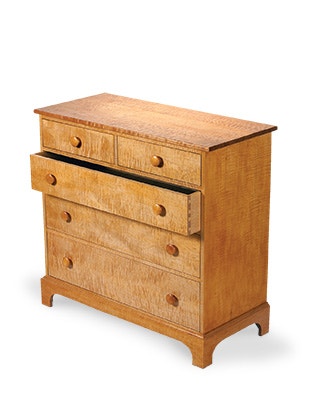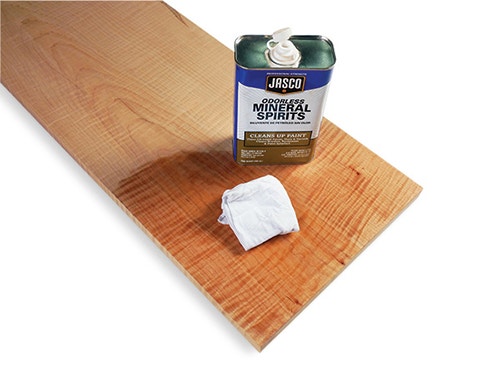Sugar Maple: Acer saccharum
If you've got mom's old rolling pin in your kitchen, or a tough-as-nails cutting board for that matter, chances are very good that it's made of Acer saccharum, known as sugar maple to syrup producers or hard maple to us woodworkers.
Among some 14 native species of maples in the United States, sugar maple and its cousin, black maple (Acer nigrum), are both sold under the general term hard maple. Hard maple makes up six percent of all the hardwood harvested in the U.S. annually. Only red oak and yellow poplar outrank it.
While plainsawn hard maple tends to be pale blonde in color, straight grained and rather plain, it has numerous indoor uses. Whether called to service for kitchen cabinet doors, gymnasium flooring, plywood veneer, various and sundry turning applications or all manner of furniture parts, maple is up to task. Moderately priced, it's also relatively easy to find in widths over 12" and in long, clear lengths. The wood cuts, routs, planes and drills cleanly and easily — provided your blades and bits are sharp. Carbide is a big help.
Be prepared for a workout, though, when it comes to lugging large or thick boards around the shop: hard maple is dense and heavy. Take your time when sanding it, too. Erasing milling marks or burns from its surfaces should be done with care, because hard maple won't hide those blemishes or your impatience very well. Start with a coarse grit and work dutifully upwards from there.
When shopping for roughsawn hard maple, avoid boards with dark stripes crossing the grain. These are often signs of sticker stain that occurs during the drying process. The black or blue marks can penetrate deeply into the lumber and be nearly impossible to remove.
Dazzling Grain

Aside from its versatility, sugar maple's other desirable trait is that it commonly produces two stunning figures: curly (also known variously as fiddleback, tiger stripe or flame) as well as bird's eye — small patterns of tight swirling dots.
My first chance to get lost in the undulating grain of top-grade fiddleback came when I built the dresser shown above. Straight out of the planer, the lumber's showy grain already teased me. But it positively lit up once I sanded it to a high polish and splashed it with mineral spirits for a sneak peek. At that moment, I wondered if any other lumber could be quite as pretty to behold. Try some for a project, and I bet you'll agree.
Shop Score Card
|
Uses: Furniture, flooring, cabinetry , veneer, musical instruments, turnings of all sorts. Hardness: Heavy, strong, hard and shock resistant. Country of Origin: Northeastern North America, from the Atlantic to Canada and southward.Workability: Works well with power or hand tools, provided bits and blades are sharp. Sands slowly; change abrasives often. Fastens and glues well. Finishing: Oils and clear film finishes accentuate grain. Dye stains and shellacs are more effective at coloring hard maple than pigment stains. Cost: Moderate for plainsawn hard maple; high for figured lumber, especially in instrument grades. |
Keep the inspiration coming!
Subscribe to our newsletter for more woodworking tips and tricks



